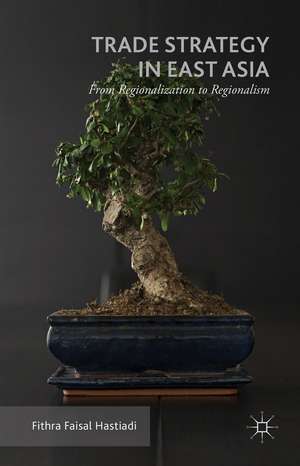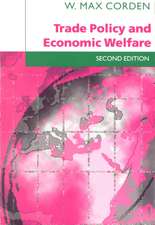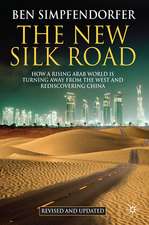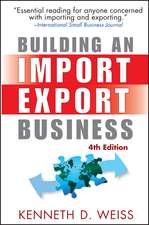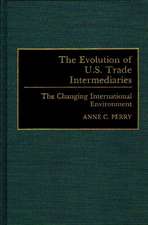Trade Strategy in East Asia: From Regionalization to Regionalism
Autor Fithra Faisal Hastiadien Limba Engleză Hardback – 6 ian 2016
This book analyzes the effect of China, Japan and Korea's trade strategy on ASEAN countries. As closer economic ties between countries in the area have expanded significantly in the last decade, economic regionalization in East Asia has proceeded in a much more dynamic fashion than regionalist projects. Hastiadi argues that regionalism in the form of Regional Trade Agreements (RTAs) is better than the present regionalization as it promotes sustainability in the future.
| Toate formatele și edițiile | Preț | Express |
|---|---|---|
| Paperback (1) | 634.32 lei 6-8 săpt. | |
| Palgrave Macmillan UK – 2 mar 2017 | 634.32 lei 6-8 săpt. | |
| Hardback (1) | 639.59 lei 6-8 săpt. | |
| Palgrave Macmillan UK – 6 ian 2016 | 639.59 lei 6-8 săpt. |
Preț: 639.59 lei
Preț vechi: 752.45 lei
-15% Nou
Puncte Express: 959
Preț estimativ în valută:
122.42€ • 127.32$ • 102.59£
122.42€ • 127.32$ • 102.59£
Carte tipărită la comandă
Livrare economică 13-27 martie
Preluare comenzi: 021 569.72.76
Specificații
ISBN-13: 9781137569660
ISBN-10: 1137569662
Pagini: 186
Ilustrații: XXIII, 186 p.
Dimensiuni: 140 x 216 x 13 mm
Greutate: 0.4 kg
Ediția:1st ed. 2016
Editura: Palgrave Macmillan UK
Colecția Palgrave Macmillan
Locul publicării:London, United Kingdom
ISBN-10: 1137569662
Pagini: 186
Ilustrații: XXIII, 186 p.
Dimensiuni: 140 x 216 x 13 mm
Greutate: 0.4 kg
Ediția:1st ed. 2016
Editura: Palgrave Macmillan UK
Colecția Palgrave Macmillan
Locul publicării:London, United Kingdom
Cuprins
Table Of Contents
Acknowledgements
Preface
1 Introduction: Making East Asian Regionalism Work
1.1 Background
1.1.1 The Political Economy Of Trade Liberalization
1.1.2 East Asian Regionalism: Trade And Fdi Integration
1.1.3 Variables
1.2 Limitation
1.3 Organization Of The Book
2 East Asian Regionalism: The Role Of North East Asian Nations
2.1 Introduction
2.2.1 Regionalism Versus Regionalization
2.2.2 Cjk's Triangular Trade
2.2.3 East Asian Regionalism
2.3 Methodology
2.3.1 Analyzing The Trade Structure Of Cjk
2.3.2 Rta/Fta
2.3.3 Economic Modalities
2.4 Results And Discussion
2.4.1 The Short And Long Run Equilibrium
2.4.2 Rta/Fta
2.4.3 Economic Modalities
2.5 Conclusion
3 The Impact Of Cjk's Vertical Intra Industry Trade On Asean4's Gdp Per Capita
3.1 Introduction
3.2 Literature Review
3.2.1 Intra Industry Trade
3.2.2 Vertical Iit And Regional Integration
3.2.3 Export Regional Concentration And Economic Growth
3.3 Methodology
3.3.1 Intra Industry Trade (Iit)
3.3.2 Regional Hirschman Index (Rhi)
3.3.3 The Panel Data Model
3.4 Results And Discussion
3.4.1 Determining The Types Of Iit
3.4.2 Regional Hirschman Index (Rhi)
3.4.3 Panel Data Model-Regression Result
3.5 Conclusion
4 The Determinants Of Cjk's Vertical Intra Industry Trade To Asean4 Countries
4.1 Introduction
4.2 Literature Review
4.2.1 Foreign Direct Investment (Fdi) And Vertical Intra Industry Trade (Viit)
4.2.2 Factor Proportions And Vertical Iit
4.2.3 Trade And Logistics
4.2.4 Exchange Rate And Trade
4.2.5 Factor Price Equalization Theorem
4.3 Methodology
4.3.1 Intra Industry Trade (Iit)
4.3.2 Logistic Performance Index (Lpi)
4.3.3 The Panel Data Model
4.4 Results And Discussion
4.4.1 The Threshold System
4.4.2 Logistic Performance Index (Lpi)
4.4.3 Panel Data Model-Regression Result
4.5 Conclusion
5 China-Japan-Korea (Cjk)'S Fta Strategy Towards Asean Countries
5.1 Introduction
5.2 Literature Review
5.2.1 Setting The Payoff Matrix
5.2.2 Domino Effect Of Fta
5.2.3 Fta Strategy Using Game Theoretical Approach
5.3 Methodology
5.3.1 Assumptions
5.3.2 Payoff Scheme
5.3.3 Response Function
5.3.4 Dominant Strategy
5.4 Results And Discussion
5.4.1 Payoff Matrix
5.4.2 Response Functions
5.4.3 Discussion
5.5 Conclusion
6 The Determinants Of East Asian Regionalism
6.1 Introduction
6.2 Basic Concepts
6.2.1 Democracy And Regionalism
6.2.2 Good Governance And Regionalism
6.2.3 Transport Infrastructure And Regionalism
6.2.4 Industrialization And Regionalism
6.2.5 2population And Regionalism
6.2.6 Education And Regionalism
6.3 Methodology
6.4 Results And Discussion
6.5 Conclusion
7 Epilogue
7.1 East Asia: An Integrated Environment
7.1.1 Intra Regional Trade: Asean+ 3
7.1.2 Trade Patterns: Asean Countries
7.2 Making East Asian Regionalism Work
7.3 Concluding Remarks
7.3.1 Set Up The North East Asian Fta
7.3.2 Production Networks And Regional Gap
7.4 Future Considerations
8 Appendix
Index
Acknowledgements
Preface
1 Introduction: Making East Asian Regionalism Work
1.1 Background
1.1.1 The Political Economy Of Trade Liberalization
1.1.2 East Asian Regionalism: Trade And Fdi Integration
1.1.3 Variables
1.2 Limitation
1.3 Organization Of The Book
2 East Asian Regionalism: The Role Of North East Asian Nations
2.1 Introduction
2.2.1 Regionalism Versus Regionalization
2.2.2 Cjk's Triangular Trade
2.2.3 East Asian Regionalism
2.3 Methodology
2.3.1 Analyzing The Trade Structure Of Cjk
2.3.2 Rta/Fta
2.3.3 Economic Modalities
2.4 Results And Discussion
2.4.1 The Short And Long Run Equilibrium
2.4.2 Rta/Fta
2.4.3 Economic Modalities
2.5 Conclusion
3 The Impact Of Cjk's Vertical Intra Industry Trade On Asean4's Gdp Per Capita
3.1 Introduction
3.2 Literature Review
3.2.1 Intra Industry Trade
3.2.2 Vertical Iit And Regional Integration
3.2.3 Export Regional Concentration And Economic Growth
3.3 Methodology
3.3.1 Intra Industry Trade (Iit)
3.3.2 Regional Hirschman Index (Rhi)
3.3.3 The Panel Data Model
3.4 Results And Discussion
3.4.1 Determining The Types Of Iit
3.4.2 Regional Hirschman Index (Rhi)
3.4.3 Panel Data Model-Regression Result
3.5 Conclusion
4 The Determinants Of Cjk's Vertical Intra Industry Trade To Asean4 Countries
4.1 Introduction
4.2 Literature Review
4.2.1 Foreign Direct Investment (Fdi) And Vertical Intra Industry Trade (Viit)
4.2.2 Factor Proportions And Vertical Iit
4.2.3 Trade And Logistics
4.2.4 Exchange Rate And Trade
4.2.5 Factor Price Equalization Theorem
4.3 Methodology
4.3.1 Intra Industry Trade (Iit)
4.3.2 Logistic Performance Index (Lpi)
4.3.3 The Panel Data Model
4.4 Results And Discussion
4.4.1 The Threshold System
4.4.2 Logistic Performance Index (Lpi)
4.4.3 Panel Data Model-Regression Result
4.5 Conclusion
5 China-Japan-Korea (Cjk)'S Fta Strategy Towards Asean Countries
5.1 Introduction
5.2 Literature Review
5.2.1 Setting The Payoff Matrix
5.2.2 Domino Effect Of Fta
5.2.3 Fta Strategy Using Game Theoretical Approach
5.3 Methodology
5.3.1 Assumptions
5.3.2 Payoff Scheme
5.3.3 Response Function
5.3.4 Dominant Strategy
5.4 Results And Discussion
5.4.1 Payoff Matrix
5.4.2 Response Functions
5.4.3 Discussion
5.5 Conclusion
6 The Determinants Of East Asian Regionalism
6.1 Introduction
6.2 Basic Concepts
6.2.1 Democracy And Regionalism
6.2.2 Good Governance And Regionalism
6.2.3 Transport Infrastructure And Regionalism
6.2.4 Industrialization And Regionalism
6.2.5 2population And Regionalism
6.2.6 Education And Regionalism
6.3 Methodology
6.4 Results And Discussion
6.5 Conclusion
7 Epilogue
7.1 East Asia: An Integrated Environment
7.1.1 Intra Regional Trade: Asean+ 3
7.1.2 Trade Patterns: Asean Countries
7.2 Making East Asian Regionalism Work
7.3 Concluding Remarks
7.3.1 Set Up The North East Asian Fta
7.3.2 Production Networks And Regional Gap
7.4 Future Considerations
8 Appendix
Index
Notă biografică
Fithra Faisal Hastiadi obtained his BA in economics from the University of Indonesia. He continued his study at Keio University, Japan, where he was awarded a master's degree. He received his PhD from Waseda University, Japan. Currently he is serving as Research and Community Engagement Manager at the Faculty of Economics and Business, University of Indonesia.
Textul de pe ultima copertă
The study of regionalism is essential as it has become a vital trend with profound regional and global impacts. Japan, Korea and China are regarded as the key actors for such action in East Asia. While regionalization has created building blocks for economic integration, the act of exclusion from regionalism will only lead to marginalization. Therefore, it is important to learn how to make it work.
This book analyzes the effect of China, Japan and Korea's trade strategy on ASEAN countries. As closer economic ties between countries in the area have expanded significantly in the last decade, economic regionalization in East Asia has proceeded in a much more dynamic fashion than regionalist projects. Hastiadi argues that regionalism in the form of Regional Trade Agreements (RTAs) is better than the present regionalization as it promotes sustainability in the future.
This book analyzes the effect of China, Japan and Korea's trade strategy on ASEAN countries. As closer economic ties between countries in the area have expanded significantly in the last decade, economic regionalization in East Asia has proceeded in a much more dynamic fashion than regionalist projects. Hastiadi argues that regionalism in the form of Regional Trade Agreements (RTAs) is better than the present regionalization as it promotes sustainability in the future.
